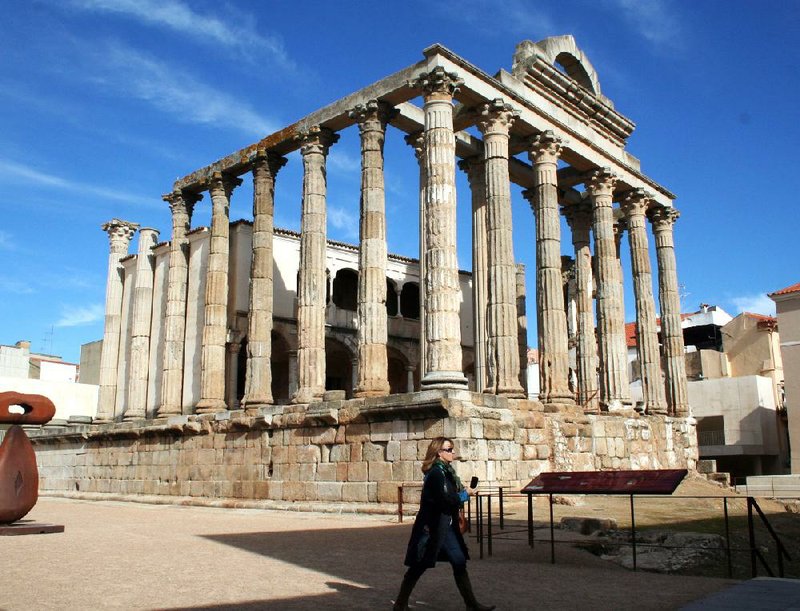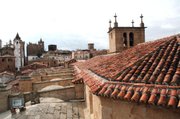MERIDA, Extremadura - Rising out of the fiery plunge pool and tiptoeing across a mosaic to tepid waters, I’m taking another step back into Roman Spain.
The Romans settled Merida in 25 B.C., and the tiny bed and breakfast of Termas Aqua Libera just north of the city is doing everything it can to revive the Roman ways in food, wine and waters.
Spagoers head first for the frigidarium, the coldest water, then hot, then tepid. Follow that up with a reclining banquet of olive relish, grilled tuna and sweet cream of pine nuts and soon you’re in a proper Roman frame of mind to tour Merida, a UNESCO World Heritage Site that’s a little clone of Rome itself.
This is Extremadura, a western region of Spain that hugs Portugal, about three hours’ drive west of Madrid. Its Latin name means “the land beyond the River Douro,” or just “frontier.” North Americans might call it the back of beyond.
But this relatively undiscovered region is a time-traveler’s dream, with hearty vestiges from Roman and Arab to Jewish and Christian times. Scratch the facade of many a Renaissance building and you’ll find another era, another culture, somewhere beneath.
For Roman ruins, you can’t beat Merida. The vast gladiatorial amphitheater and arts theater anchor the ancient city, with many Roman statues and treasures safely tucked away in the Museum of Roman Art across the street. Trajan’s Arch, the Forum and the Temple of Diana, which was really dedicated to Rome’s imperial cult, are an easy stroll away.
The Roman Bridge spans the Guadiana River for nearly half a mile, as it has since Emperor Augustus invited his retired soldiers to settle Augusta Emerita in 25 B.C.
Merida is a linchpin on the ancient Via dela Plata, the north-south Silver Road that the Romans paved. South along the road is another Roman landmark, the only remaining Roman four-sided arch, at Caparra.
Much of vast Caparra, which guide Marco Mangut predicted “will be our small and humble Pompeii,” is reduced to foundations. But the arch is one of those Roman masterworks that draw admirers from all over the world. For all their faults on a modern human rights level, no one built like the Romans.
At Termas Aqua Libera, archaeologist Santi Feijoo Martinez and his engineer wife, Noemi Cabalgante Reina, counter a misperception about the Romans perpetuated by Hollywood. The movie version of Roman life would make you think that at mealtimes they did nothing but gorge themselves as they lazed about on couches.
The Termas Aqua Libera repast consists of balanced courses of Mediterranean vegetables and lean meat, skewered by guests as wooden bowls and platters float by in the center of a triclinium reclining couch. As many as nine Roman wannabes, garbed in robes and stoles, lean in to chat and sip rose petal wine as the nibbles drift by.
Food, of course, is one of the richest portals into bygone cultures. Extremadura chefs covet the plump amanitas cesarias mushrooms that are still called Roman gold. These often swim in local olive oil with garlic shavings.
Arabs brought the figs and almonds that pop up in dozens of sweets, plus the wicked-black coffee that ends each meal.
Jews brought orange water to add their own sweetness and developed a secret recipe to keep them free from the Inquisitors. After the Jews’ initial welcome in Spain, pogroms started in 1391. Jews fled to Extremadura from more inhospitable parts of Spain, many converting to Catholicism. Whether the conversions were genuine or not, mamas taught their daughters the secret of cooking kosher lamb to make it smell like pork to nosy neighbors.
After the final expulsion of the Jews by King Ferdinand and Queen Isabella in 1492, Extremadura’s Jews fled west to Portugal. There, the last woman to know the secret pork-aroma recipe died about 10 years ago.
After the final Reconquest of Extremadura from the Arabs, Christians put their stamp on every aspect of life. Mosques became churches; synagogues became rubble.
Spain’s paradores, the national network of inns retrofitted into historic buildings, show this pancaking of cultures in dozens of quirky ways.
The Parador of Merida, for instance, is tucked inside the 18th-century Convent of Jesus, atop an ancient Roman temple devoted to the Concord of Emperor Augustus.
The parador highlights its own Garden of Antiquities, with Roman, Visigoth and Mudejar relics. The Visigoths came from what is now modern Sweden to assume the glory that was Rome, about the fifth century. Mudejar architecture is found only in the Iberian Peninsula of the Middle Ages, when Muslim artisans remained behind after the Catholic Reconquest of Arab Spain.
With its convent feel, Merida’s parador is the place to try Monastery Cake, with puff pastry, cream and creme brulee.
The Parador of Caceres spotlights in its lobby a Roman funeral stele found during excavations. Rising through Celtic, Roman and Arab civilizations, Caceres today retains a perfectly intact medieval core, another of Extremadura’s UNESCO World Heritage Sites.
Compared with that, Jarandilla’s parador is relatively modern. It dates from the 16th century, when Holy Roman Emperor Charles V was casting about for a retirement spot. In 1555, he abdicated in favor of his son Filipe II. The ruler of more than half the known world decided to collect his pension at the Monastery of Juste, but the monks needed time to build his royal chambers. So the ex-emperor moved into the summer castle of the Count of Oropesa in Jarandilla de la Vera.
“How difficult it is,” the emperor said wistfully, “when everything falls, not to fall, too.” Because he arrived in November, Charles V ordered a fireplace for his quarters, and the impressive hearth still holds pride of place in the Emperor’s Lounge. After Charles moved on to Juste, the owners proudly affixed his stone crest to the castle wall.
Maybe the most stunning multicultural parador is in the walled market city of Plasencia, where a vast Gothic convent is built atop a synagogue whose ruins are right outside the guest rooms.
This was a prosperous Dominican friary, built in the 15th century with glorious star ribbed vaulting in the chapter house and a stone staircase so awe-inspiring that it was called “The Staircase of the Air.” Its broad stone steps still seem to hang in midair, now as the showstopper of the bar.
Parador designers often have fun with the retro fittings. Peek through the confessional doors to see a pay phone and a cigarette machine.
The monks’ old wine cellar, dug three stories deep into rock, is now the cocktail lounge, its stone vaults and cozy couches illuminated entirely by candles.
More humble than Plasencia, the Convent of Santa Clara in Trujillo was nonetheless a religious landmark for more than 450 years. Nuns of the Immaculate Conception order lived and worked here from 1533 until the parador opened in 1984, in the city that launched Conquistador half brothers Francisco and Hernando Pizarro toward the New World.
The nuns’ only communication with the outside world still remains on the parador’s stone facade - a simple wooden turntable through which they sent items out and brought what they needed into their cloisters.
Some of the convent’s key elements have been lost over time, but sensitive travelers may feel the spirit of one nun who remains behind. Beneath the church’s choir, now inaccessible, lies Francisca Mercado Pizarro, the daughter of Conquistador Hernando Pizarro and Isabel Mercado, a nun in this convent.
For more information, visit these websites: turismoextremadura.com and spain.info.
Travel, Pages 52 on 03/30/2014


